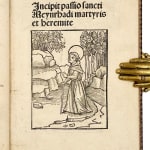![Meynradus von Einsiedeln, Passio Sancti Meynradi martyris et heremite. Ed. Sebastian Brant, Basel. Michael Furter, XII. kal. octobris [= 20 Sept.] 1496.](https://artlogic-res.cloudinary.com/w_1600,h_1600,c_limit,f_auto,fl_lossy,q_auto/artlogicstorage/hsrarebooks/images/view/7a0a3ec58d2072a63b73254cd5ee1d06j/hsrarebooks-meynradus-von-einsiedeln-passio-sancti-meynradi-martyris-et-heremite.-ed.-sebastian-brant-basel.-michael-furter-xii.-kal.-octobris-20-sept.-1496..jpg)
![Meynradus von Einsiedeln, Passio Sancti Meynradi martyris et heremite. Ed. Sebastian Brant, Basel. Michael Furter, XII. kal. octobris [= 20 Sept.] 1496.](https://artlogic-res.cloudinary.com/w_1600,h_1600,c_limit,f_auto,fl_lossy,q_auto/artlogicstorage/hsrarebooks/images/view/39a702a8cfc08d0550430c85959a40e1j/hsrarebooks-meynradus-von-einsiedeln-passio-sancti-meynradi-martyris-et-heremite.-ed.-sebastian-brant-basel.-michael-furter-xii.-kal.-octobris-20-sept.-1496..jpg)
![Meynradus von Einsiedeln, Passio Sancti Meynradi martyris et heremite. Ed. Sebastian Brant, Basel. Michael Furter, XII. kal. octobris [= 20 Sept.] 1496.](https://artlogic-res.cloudinary.com/w_1600,h_1600,c_limit,f_auto,fl_lossy,q_auto/artlogicstorage/hsrarebooks/images/view/1dde0df54e02df6ebdae23d19038cefdj/hsrarebooks-meynradus-von-einsiedeln-passio-sancti-meynradi-martyris-et-heremite.-ed.-sebastian-brant-basel.-michael-furter-xii.-kal.-octobris-20-sept.-1496..jpg)
![Meynradus von Einsiedeln, Passio Sancti Meynradi martyris et heremite. Ed. Sebastian Brant, Basel. Michael Furter, XII. kal. octobris [= 20 Sept.] 1496.](https://artlogic-res.cloudinary.com/w_1600,h_1600,c_limit,f_auto,fl_lossy,q_auto/artlogicstorage/hsrarebooks/images/view/489bf4cb2e101958b40dd31bb064627fj/hsrarebooks-meynradus-von-einsiedeln-passio-sancti-meynradi-martyris-et-heremite.-ed.-sebastian-brant-basel.-michael-furter-xii.-kal.-octobris-20-sept.-1496..jpg)
![Meynradus von Einsiedeln, Passio Sancti Meynradi martyris et heremite. Ed. Sebastian Brant, Basel. Michael Furter, XII. kal. octobris [= 20 Sept.] 1496.](https://artlogic-res.cloudinary.com/w_1600,h_1600,c_limit,f_auto,fl_lossy,q_auto/artlogicstorage/hsrarebooks/images/view/c202c636e0ec5b826912304be511b21ej/hsrarebooks-meynradus-von-einsiedeln-passio-sancti-meynradi-martyris-et-heremite.-ed.-sebastian-brant-basel.-michael-furter-xii.-kal.-octobris-20-sept.-1496..jpg)
![Meynradus von Einsiedeln, Passio Sancti Meynradi martyris et heremite. Ed. Sebastian Brant, Basel. Michael Furter, XII. kal. octobris [= 20 Sept.] 1496.](https://artlogic-res.cloudinary.com/w_1600,h_1600,c_limit,f_auto,fl_lossy,q_auto/artlogicstorage/hsrarebooks/images/view/0fc49a9f78407d5b8b4c313c041c36fcj/hsrarebooks-meynradus-von-einsiedeln-passio-sancti-meynradi-martyris-et-heremite.-ed.-sebastian-brant-basel.-michael-furter-xii.-kal.-octobris-20-sept.-1496..jpg)
Meynradus von Einsiedeln
Passio Sancti Meynradi martyris et heremite. Ed. Sebastian Brant, Basel. Michael Furter, XII. kal. octobris [= 20 Sept.] 1496.
The legend of the Swiss Saint Meinrad and the foundation of Einsiedeln Abbey.
First Latin edition, this small incunable contains the account of the life and martyrdom of St. Meinrad of Einsiedeln, illustrated with 21 fine, large woodcuts. Sebastian Brant's rare Latin edition is based on a 12th century manuscript.
First Latin edition, this small incunable contains the account of the life and martyrdom of St. Meinrad of Einsiedeln, illustrated with 21 fine, large woodcuts. Sebastian Brant's rare Latin edition is based on a 12th century manuscript.
$ 60,000.00
Further images
4to, (193 x 140 mm). 14 ff., with 21 large woodcuts from 19 blocks on title-page and within the text. Full brown morocco by Francisque Cuzin (1836-90), regarded at the time as the finest bookbinder in the world, double gilt rules to covers and spine, gilt arms to covers; leading edges gilt, inner dentelle gilt (ca. 1880), marbled endpapers, all edges gilt. An immaculate copy.
Meinrad became priest and monk on the Reichenau island in Lake Constance and decided to live as a hermit. First he settled at Etzel Pass, but in 835 he retreated to the "Finsterer Wald" (Dark Forest, in today's canton Schwyz), where he was assassinated by two robbers on 21 January 861. According to the legend, ravens revealed the identities of the murderers, who thus were caught and executed. At the place of Meinrad's hermitage Benedictine monks founded the monastery of Einsiedeln (the name signifying "hermitage"), whose abbots were elevated to the rank of princes by Rudolf of Habsburg in 1274. Einsiedeln Abbey, whose present buildings date from the early 18th century, remains one of the world's most important destinations for pilgrims.
The present Latin edition of the Passio Meynradi was edited by Sebastian Brant and was probably commissioned by Albrecht of Bonstetten (deacon of Einsiedeln from 1470 onwards). The redaction of the text was likewise attributed to him - erroneously, as we know now: as Gebhard Müller discovered, the text is based on cod. 249 of the Stiftsbibliothek Einsiedeln (Ink.-Kat. Einsiedeln, no. 558). This 12th century manuscript is a copy of the Vita Meinradi, which a monk of the Reichenau had compiled as early as the 9th century (Verfasserlexikon I, cols. 176-179).
The legend was first translated into German in the 14th century. The first printed version of the text in German appeared ca. 1460 in the form of a blockbook, probably in Basel. After the first German typographic editions of 1481/82 (Basel) and ca. 1495 (Nuremberg) followed, in ca. 1496, an edition from Michael Furter's press in Basel ("Von sant Meinrat ein hübsch lieplich lesen, was ellend und armut er erlitten hat"; GW M29717). Shortly after, he published the present first Latin edition, dated on 20 September 1496. This edition is sometimes thought to have been printed before the German edition (e.g. by Arnim, Bodemann), but this is unlikely because of the condition of the woodcuts.
The lively three-quarter-page illustrations depict episodes from the life of the saint: his travels on land and on board a ship, the founding of his hermitage, the attempts of two devils to seduce him, his assassination, the exposition of the murderers, etc. The pictures are based on the illustrations of the blockbook, although the order of the images sometimes differs and some are reversed. According to Hieronymus they may be due to the Master of Verardus. Furter's preceding German edition contained 37 woodcuts, of which a selection of 21 illustrations were used for the present Latin edition. Furter used these woodcuts for several reprints until 1512, as well as for Petermann Etterlin's "Chronik der Eidgenossenschaft" (1507). Subsequently, the series was repeatedly reused by other printers up to 1587, damaged blocks being substituted when necessary.
H 12453*. Goff P-142. GW M29714. Schäfer 232. Bod-inc M-213. Sheppard 2519, 2520. Proctor 7731. BMC III 784. BSB-Ink P-27. ISTC im00531050.
Provenance: Victor Masséna, duc de Rivoli, prince of Essling (1836-1910), with his "VM" device to spine and his arms gilt to upper cover; Hoepli (Milano), Essling sale 1939, lot 57 (pl. XIX); Maurice Burrus (1882-1959), Alsatian tobacco magnate and deputé de Haute-Rhin (his bookplate to front flyleaf).
Meinrad became priest and monk on the Reichenau island in Lake Constance and decided to live as a hermit. First he settled at Etzel Pass, but in 835 he retreated to the "Finsterer Wald" (Dark Forest, in today's canton Schwyz), where he was assassinated by two robbers on 21 January 861. According to the legend, ravens revealed the identities of the murderers, who thus were caught and executed. At the place of Meinrad's hermitage Benedictine monks founded the monastery of Einsiedeln (the name signifying "hermitage"), whose abbots were elevated to the rank of princes by Rudolf of Habsburg in 1274. Einsiedeln Abbey, whose present buildings date from the early 18th century, remains one of the world's most important destinations for pilgrims.
The present Latin edition of the Passio Meynradi was edited by Sebastian Brant and was probably commissioned by Albrecht of Bonstetten (deacon of Einsiedeln from 1470 onwards). The redaction of the text was likewise attributed to him - erroneously, as we know now: as Gebhard Müller discovered, the text is based on cod. 249 of the Stiftsbibliothek Einsiedeln (Ink.-Kat. Einsiedeln, no. 558). This 12th century manuscript is a copy of the Vita Meinradi, which a monk of the Reichenau had compiled as early as the 9th century (Verfasserlexikon I, cols. 176-179).
The legend was first translated into German in the 14th century. The first printed version of the text in German appeared ca. 1460 in the form of a blockbook, probably in Basel. After the first German typographic editions of 1481/82 (Basel) and ca. 1495 (Nuremberg) followed, in ca. 1496, an edition from Michael Furter's press in Basel ("Von sant Meinrat ein hübsch lieplich lesen, was ellend und armut er erlitten hat"; GW M29717). Shortly after, he published the present first Latin edition, dated on 20 September 1496. This edition is sometimes thought to have been printed before the German edition (e.g. by Arnim, Bodemann), but this is unlikely because of the condition of the woodcuts.
The lively three-quarter-page illustrations depict episodes from the life of the saint: his travels on land and on board a ship, the founding of his hermitage, the attempts of two devils to seduce him, his assassination, the exposition of the murderers, etc. The pictures are based on the illustrations of the blockbook, although the order of the images sometimes differs and some are reversed. According to Hieronymus they may be due to the Master of Verardus. Furter's preceding German edition contained 37 woodcuts, of which a selection of 21 illustrations were used for the present Latin edition. Furter used these woodcuts for several reprints until 1512, as well as for Petermann Etterlin's "Chronik der Eidgenossenschaft" (1507). Subsequently, the series was repeatedly reused by other printers up to 1587, damaged blocks being substituted when necessary.
H 12453*. Goff P-142. GW M29714. Schäfer 232. Bod-inc M-213. Sheppard 2519, 2520. Proctor 7731. BMC III 784. BSB-Ink P-27. ISTC im00531050.
Provenance: Victor Masséna, duc de Rivoli, prince of Essling (1836-1910), with his "VM" device to spine and his arms gilt to upper cover; Hoepli (Milano), Essling sale 1939, lot 57 (pl. XIX); Maurice Burrus (1882-1959), Alsatian tobacco magnate and deputé de Haute-Rhin (his bookplate to front flyleaf).
Join our mailing list
* denotes required fields
We will process the personal data you have supplied in accordance with our privacy policy (available on request). You can unsubscribe or change your preferences at any time by clicking the link in our emails.






